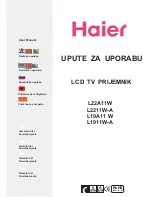
PowerTalk™ Manual
SGC Inc. SGC Building, 13737 S.E. 26th St. P.O.Box 3526, Bellevue, WA. 98009 USA
Fax: 206-746-6384 • Tel: 206- 746-6310 • 1-800-259-7331
© 1994 SGC, Inc.
June 28, 2004; 15:46
SG-2000
PowerTalk
TM
Head
w/
ADSP
TM
&
SNS
TM
(Catalog Number 04-22)
For the
SG-2000
HF SSB
Installation and Operations Manual
Revised: Sept. 6, 1995
Summary of Contents for PowerTalk Head w/ADSP & SNS 04-22
Page 70: ......


































